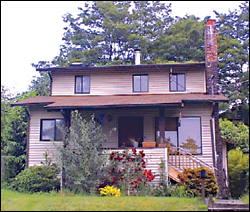I was between a major bathroom renovation and a new back deck when I began to reconsider what I should be driving. My little 1990 Honda Civic three-door hatchback just wasn’t that great for lugging around giant plastic shower surrounds and a seemingly endless stream of two-by-fours. “Maybe I should buy a truck,” I said to my younger brother about three years back. “Oh, God,” he groaned. “You aren’t going to become a truck girl, are you?”
The truck girl, he explained, is the modern, independent woman who attempts to fix up her own house—probably one she bought herself. She already knows her way around most power tools, and the natural next step is to purchase a more suitable vehicle to haul Sheetrock and plywood. She doesn’t need men around to help her out.
“Maybe it’s because Seattle is a more liberal place,” muses Liza Keckler, producer for Toolbelt Diva, a new local home-repair show hosted by and geared toward women (see related interview, p. 37). “But it’s probably also because Seattle is an expensive place to own property, so fewer people can afford to pay for the work to be done by someone else.”
That’s certainly borne out by my newbie homeownership experience in Seattle, where one-fifth of the households are headed by women. When I bought my first place, I had zero home-renovation intelligence. And I didn’t want to beg my brother and father for help with every project on my four-bedroom, two- bath fixer-upper. I started, nervously, with what seemed to be simple projects: tearing things down, painting, and tiling.
“Demolition is definitely the easy part,” chuckles Karen Buhler, a glassblower who bought and renovated a 1925 Ballard bungalow on her own and an ideal mentor to all future truck girls. Her first big project was to tear down and rebuild the front porch because her contractor wanted too much for the job. That was the beginning of a long learning process, she recalls. “Then it’s like, ‘Now what?'”
Here are some of the tips she, I, and others have gathered along the way:
Ask, ask, ask and practice, practice, practice. Though she had studied architecture, Buhler said it took her six months to gain the confidence to start building. But once the porch was done, it was easy to move on to the next projects, from rebuilding her back stairs and a wine cellar to remodeling her garage into a glassblowing studio.
“I just asked a lot of questions,” said Buhler, now 46. “I lived around a bunch of woodworkers, and I borrowed a lot of tools. And I read some manuals. It’s kind of like cooking. When I first started with construction, I felt I didn’t even know the language. But it’s a train of thought, and you can develop it. It is knowledge gained from experience.”
Free classes. Painting the walls of my fixer wasn’t too hard for me to figure out on my own. But tiling? I didn’t even know where to start. A two-hour free Home Depot class changed my life. (The company has also launched free “Do-It-Herself” classes for women on various topics; call your local store for schedules.) I tiled my kitchen counters, bathroom floor, and a sink tabletop. My brother, a carpenter, even asked me to tile the kitchen counter and dining room table of his houseboat. My crowning moment came when I tiled the kitchen counters for an apartment he renovated. I felt like a pro.
So you want to build your own house? Twenty years ago, social worker Linda Sheehan enrolled in the Seattle Central Community College carpentry program, which shows students in four quarters how to build a house from the ground up—from the framing to the plumbing and electrical work. She learned enough to design and act as general contractor for a two-room addition on a cabin she owns.
“You know, it doesn’t take a genius to do a lot of this stuff. It’s very straightforward,” says Sheehan, who remains a social worker but does all the fixit work around her house and neighborhood. The Wood Construction Center at SCCC costs roughly $750 per quarter these days, and female enrollment has grown from Sheehan’s day, when only a few other women were in the class, to about 50 percent to 60 percent women in each program. (For more information, call 206-587-5460 or go to www.seattlecentral.edu.)
Call in the (distaff) experts. If you aren’t comfortable with a job, you may still need to contract out the work—and the best man for the job may be a woman. Take Judi Ostrow, owner of AAA Furnace Installation (253-351-6827), who grew up working around furnaces with her father and specializes in educating women customers. Or Sue Grosz of Small Jobs (425- 486-6151), who paints, builds, and/or fixes walls of all types. Both come highly recommended by their female clientele.
Still, the pickings are slim: The King-Snohomish County Master Builders Association lists only 51 certified women- or minority-owned businesses in their 3,700-plus membership. And don’t forget to ask for references. Seanna Jordan, who prefers to use women contractors to fix her home when she can find good ones or can’t do it herself, ran into a certain female plumber who was “too expensive and opinionated for my taste.”
So, finally, how much truth is there to the ruggedly independent, don’t-need-no-man truck-girl persona? Buhler still drives a 1989 “ugly Toyota van built on a truck chassis,” claiming it’s better in the rain. Sheehan reports with sadness that she recently parted with her long-treasured Datsun pickup. Both are still very much hands-on when it comes to home repairs, and both happen to be happily married. They say that both parties can wear the tool belt in a healthy household. Doing it yourself doesn’t mean going it alone. Says Buhler: “When my husband and I first met, my friend Laura and I jack-hammered the cement in our back parking lot for planters, while he baked lasagna in the kitchen.”
And what do I drive today? After selling my fixer last month, I’ll admit I’m not looking to buy more real estate anytime soon. But I still sometimes sift through the car ads looking for a bright red “access-cab” Toyota Tacoma with V6 engine, dual airbags, and six-speaker sound system. Think how much plywood that baby could haul. A girl’s got to dream.







